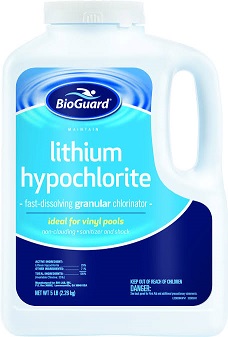| Product Name: | Lithium hypochlorite | | Synonyms: | hypochloritedelithium;Hypochlorous acid, lithium salt;Hypochlorousacid,lithiumsalt;Hypure L;LiOCl;lithiumchlorideoxide;lithiumhypochloritemixture;lithiumoxychloride | | CAS: | 13840-33-0 | | MF: | ClLiO | | MW: | 58.39 | | EINECS: | 237-558-1 | | Product Categories: | Inorganics | | Mol File: | 13840-33-0.mol |  |
| | Lithium hypochlorite Chemical Properties |
| | Lithium hypochlorite Usage And Synthesis |
| Chemical Properties | Lithium hypochlorite is a white, granular solid or tablet with a Chlorine odor. It is used for sanitizing, disinfecting and controlling algae in swimming pools, and as laundry bleach.
Lithium hypochlorite is granular Chlorine with a 35% AC. Lithium dissolves very quickly making it great for super chlorinating (shocking) vinyl lined and fiberglass pools and those who have problems with hard water and Calcium levels. But its low active strength and high cost make it home pool disinfectant rather than commercial pool disinfectant.

| | Uses | Commercial lithium hypochlorite [13840-33-0], LiOCl, is a solid with ~35% available chlorine. It is made from concentrated solutions of sodium hypochlorite and lithium chloride. It consists of 30% lithium hypochlorite and various other salts.
Lithium hypochlorite is used in I & I laundry detergents and I & I dry laundry bleaches. Like sodium hypochlorite, it does not precipitate soaps and other anionic detergents. However, lithium hypochlorite is an expensive source of available chlorine and not much is used for bleaching. Its principal use is as a shocking agent for swimming pool disinfection.
| | Preparation | Lithium hypochlorite is prepared commercially from a purified solution obtained from the sulfuric acid-spodumene recovery process for lithium. The solution containing lithium, sodium, potassium, hydroxide and sulfate ions is chlorinated and evaporated. The solid is dried to yield an impure lithium hypochlorite having 35-40% available chlorine. The material is used as a bleach and disinfectant, particularly in home swimming pools.
| | Chemical Properties | white granules; oxidant; can ignite organic materials; can be prepared by action of chlorine on a solution of LiOH; used as a bleach and an oxidizing agent, sanitizer for swimming pools, cooling water treatment [HAW93] [KIR81] [FMC93] | | Uses | Lithium hypochlorite is an algicide, disinfectant, fungicide and food contact surface sanitizer. Its primary pesticidal use is to control algae, bacteria and mildew in swimming pool water systems, hot tubs and spas; approximately 2,000,000 pounds of the active ingredient were used for this purpose in 1989. It also is used to sanitize food and cheese processing plant equipment, dairies, and eating establishment equipment and utensils. Lithium hypochlorite is formulated as a ready-to-use liquid and a soluble solid concentrate. It is applied to swimming pool water using a skimmer basket, and to equipment or utensils by hand or through use of a dish washing machine. Lithium is an element that occurs naturally at low levels in food and drinking water. | | General Description | A white granular solid or tablets compressed from the granules, with an odor of chlorine. Noncombustible but accelerates the burning of combustible material. Prolonged exposure of closed containers to heat may result in vigorous decomposition and rupture of the container. Used as a dry bleach. Generally toxic. An irritant. | | Air & Water Reactions | Soluble in water. Decomposes slowly in water with the evolution of chlorine gas. | | Reactivity Profile | LITHIUM HYPOCHLORITE is a powerful oxidizing agent. particularly in the presence of water or at higher temperature as LITHIUM HYPOCHLORITE decomposes to release oxygen and chlorine gases. Forms highly explosive NCl3 on contact with urea or ammonia. When heated or on contact with acids, produces highly toxic fumes of chlorine gas [Sax, 9th ed., 1996, p. 1905]. | | Health Hazard | Inhalation, ingestion or contact (skin, eyes) with vapors or substance may cause severe injury, burns or death. Fire may produce irritating, corrosive and/or toxic gases. Runoff from fire control or dilution water may cause pollution. | | Fire Hazard | These substances will accelerate burning when involved in a fire. Some may decompose explosively when heated or involved in a fire. May explode from heat or contamination. Some will react explosively with hydrocarbons (fuels). May ignite combustibles (wood, paper, oil, clothing, etc.). Containers may explode when heated. Runoff may create fire or explosion hazard. | | Safety Profile | A powerful oxidizer.
An eye, skin, and mucous membrane
irritant. When heated to decomposition it
emits very toxic fumes of Li2O and Cl-.
Used for swimming pool chlorination, and
as a laundry bleach. See also LITHIUM
COMPOUNDS and HYPOCHLORITES. |
| | Lithium hypochlorite Preparation Products And Raw materials |
|